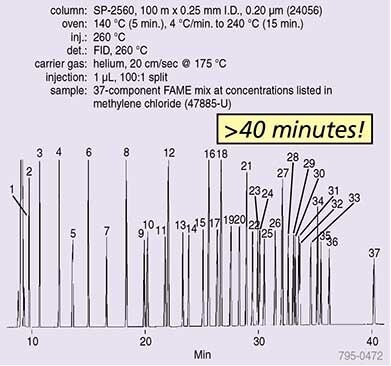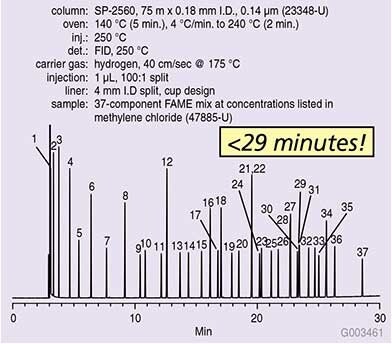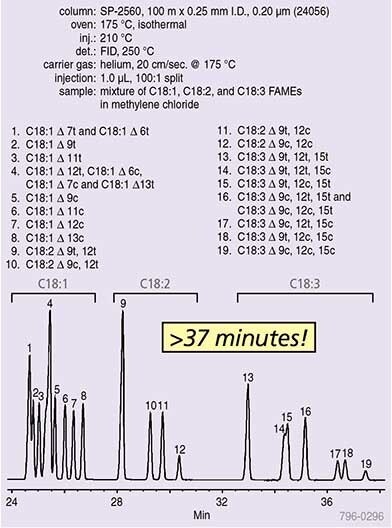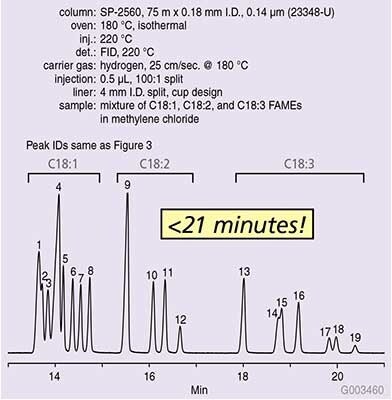Fast GC Analysis of Detailed cis/trans Fatty Acid Methyl Esters (FAMEs) on the 75 m SP™-2560 Capillary Column
Trans Fat Analysis
Because of the adverse health effects of trans fats, the United States Food and Drug Administration (FDA) requires that food manufacturers list trans fat content on the food’s Nutrition Facts panel (1,2). These labeling requirements have placed added pressure on food analysts to process more samples, which in turn creates the need for a rapid analytical method.
SP-2560: The Best GC Phase Available for Detailed cis/trans FAME Analyses
Cis/trans selectivity increases with increasing column polarity (percentage of biscyanopropyl). The 100 m x 0.25 mm internal diameter (I.D.), 0.20 μm SP-2560 column is the longest, most polar column currently available. By combining both selectivity of the phase and column efficiency (by virtue of long column length), highly polar 100% biscyanopropyl SP-2560 capillary GC columns provide high resolution cis/trans FAME isomer separation. The SP-2560 column is specified in the Association of Official Analytical Chemists (AOAC) cis/trans FAME method (3).
Analytical Challenge: Improved Throughput of Detailed cis/trans FAME Analyses
To increase throughput of the detailed cis/trans FAME analysis, Fast GC principles were applied by reducing column length, column I.D., film thickness, and carrier gas viscosity. The result is a significant reduction in analysis time compared to the 100 m column method: 30% reduction of the 37-component FAME sample (Figures 1 and 2), and nearly 50% reduction of the detailed analysis of the C18 isomer mix (Figures 3 and 4). Note that in both cases, peak shape and resolution does not suffer, even with the shorter analysis times.

Figure 1. 37-Component FAME Mix on the 100 m SP-2560 Column (24056)

Figure 2. 37-Component FAME Mix on the 75 m SP-2560 Column (23348-U)

Figure 3. Detailed Analysis of C18 FAME Isomers on the 100 m SP-2560 Column (24056)

Figure 4. Detailed Analysis of C18 FAME Isomers on the 75 m SP-2560 Column (23348-U)
| 1. Butyric Acid Methyl Ester (C4:0) at 4 wt% |
| 2. Caproic Acid Methyl Ester (C6:0) al 4 wt% |
| 3. Caprylic Acid Methyl Ester (C8:0) at 4 wt% |
| 4. Capric Acid Methyl Ester (C10:0) at 4 wt% |
| 5. Undecanoic Acid Methyl Ester (C11:0) at 2 wt% |
| 6. Lauric Acid Methyl Ester (C12:0) al 4 wt% |
| 7. Tridecanoic Acid Methyl Ester (C13:0) at 2 wt% |
| 8. Myristic Acid Methyl Ester (C14:0) at 4 wt% |
| 9. Myristoleic Acid Methyl Ester(C14:1) at 2 wt% |
| 10. Pentadecanoic Acid Methyl Ester (C15:0) at 2 wt% |
| 11. cis-10-Pentadecenoic Acid Methyl Ester (C15:1) at 2 wt% |
| 12. Palmilic Acid Methyl Ester (C16:0) at 6 wt% |
| 13. Palmitoleic Acid Methyl Ester (C16:1) at 2 wt% |
| 14. Heptadecanoic Acid Methyl Ester (C17:0) at 2 wt% |
| 15. cis-10-Heptadecanoic Acid Methyl Ester (C17:1) at 2 wt% |
| 16. Stearic Acid Methyl Ester, (C18:0) at 4 wt% |
| 17. Elaidic Acid Methyl Ester (C18:1n9t) at2 wt% |
| 18. Oleic Acid Methyl Ester (C18:1n9c) at 4 wt% |
| 19. Linolelaidic Acid Methyl Ester (C18:2n6t) at 2 wt% |
| 20. Linoleic Acid Methy Ester (C18:2n6c) at 2 wt% |
| 21. Arachidic Acid Methyl Ester (C20:0) at 4 wt% |
| 22. g-Linolenic Acid Methyl Ester (C18:3n6) at 2 wt% |
| 23. cis-11-Eicosenoic Acid Methyl Ester (C20:1) al 2 wt% |
| 24. Linolenic Acid Methyl Ester (C18:3n3) at 2 wt% |
| 25. Henelcosanoic Acid Methyl Ester (C21:0) at 2 wt% |
| 26. cis-11,14-Elcosenoic Acid Methyl Ester (C20:2) at 2 wt% |
| 27. Behenic Acid Methyl Ester (C22:0) at 4 wt% |
| 28. cis-8,11,14-Elcosatrienoic Acid Methyl Ester (C20:3n6) at 2 wt% |
| 29. Erucic Acid Methyl Ester (C22:1n9) at 2 wt % |
| 30. cis-11,14,17-Elcosatrienoic Acid Methyl Ester (C20:3n3) at 2 wt% |
| 31. Arachidonic Acid Methyl Ester (C20:4n6) at 2 wt% |
| 32. Tricosanoic Acid Methyl Ester (C23:0) at 2 wt% |
| 33. cis-13,16-Docasadienoic Acid Methyl Ester (C22:2) at 2 wt% |
| 34. Lignoceric Acid Methyl Ester (C24:0) at 4 wt % |
| 35. cis-5,8,11,14, f7-Elcosapentaenoic Acid Methyl Ester (C20:Sn3) al 2 wt% |
| 36. Nervonic Acid Methyl Ester (C24:1) at 2 wt% |
| 37. cis-4,7,10,13,16,19-Docasahexaenoic Acid Methyl Ester (C22:6n3) at 2 wt% |
In both examples shown here, the loss of total theoretical plates by reducing the column length from 100 m to 75 m is offset by the narrower column I.D. (0.18 vs. 0.25 mm), thinner film (0.14 vs. 0.20 μm) and the higher diffusivity, lower viscosity carrier gas (hydrogen vs. helium). Simply put, the 75 m x 0.18 mm I.D. SP-2560 column does what the 100 m x 0.25 mm I.D. column does, but in a much shorter time. The 0.18 mm I.D. column is compatible with both conventional and Fast GC instruments.
Conclusion
Supelco offers food analysts performing detailed cis/ trans FAME analyses solutions in terms of both resolving power and speed. The 100 m SP-2560 column provides excellent resolution and is a workhorse column for detailed cis/trans FAME analyses. Now, for analysts interested in improving throughput, a Fast GC version SP-2560 column in 75 m x 0.18 mm, 0.14 μm dimensions, offered exclusively by Supelco, provides both the high resolution and high speed needed to achieve high throughput with detailed cis/trans FAME analyses.
References
To continue reading please sign in or create an account.
Don't Have An Account?